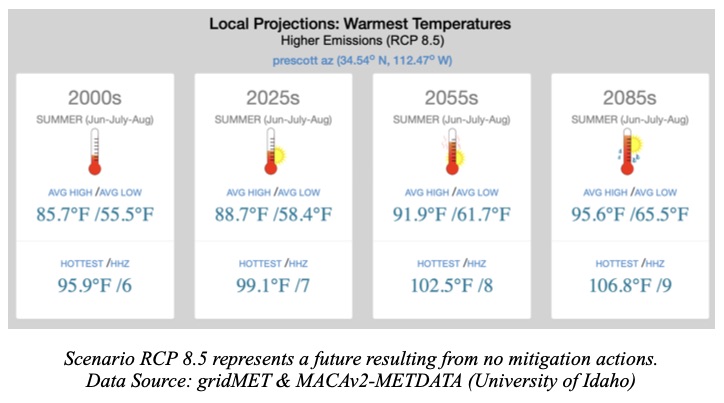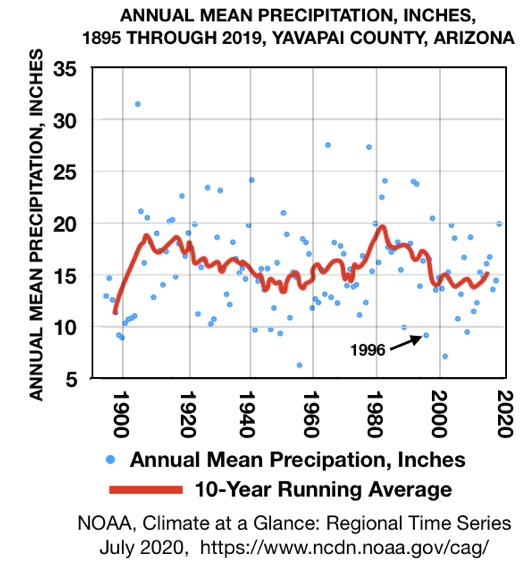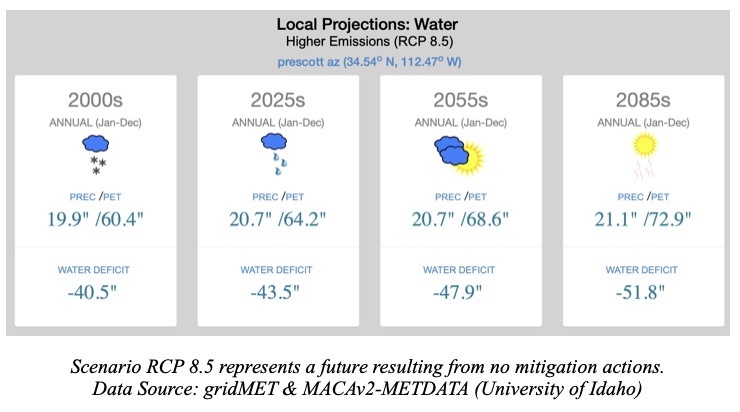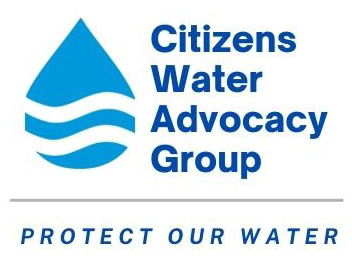Higher Temperatures, Lower Precipitation, and Evapotranspiration Act Together to Reduce Natural Recharge of the Aquifer
Excessive groundwater pumping and planned population growth are only part of our future water shortage problem.
Climate change is now reducing natural recharge, the primary source of water to renew the aquifer. Recent weather history and projected climate trends show a pattern of increasing temperatures and increased aridity. This will certainly cause a reduction in the volume of average annual natural recharge. Less recharge will cause aquifer water levels to fall even faster.
Climate change Net-Zero Groundwater requires global action. Mitigation is a slow process, responding very slowly to corrective actions. Significant future heating is “baked in” due to previous greenhouse gas emissions. Although our region has little short-term control over the effects of climate change, we should now begin to manage our water resources with full consideration of our climate future. This is not now being done by the state, county, AMA, or cities.
In future decades, climate change will become increasingly severe. Projections of changes in our regional climate are now reasonably accurate. The next few articles examine our historical temperature and precipitation and project how our climate will change in the future.
Evapotranspiration Reduces Recharge Calculation based on ADWR data suggests that the average annual precipitation in the PrAMA from 1940 through 2012 was about 466,000 acre-feet. Estimated annual stream flow exiting the PrAMA, 1973 through 2011, was approximately 12,000 acre-feet per year. The balance, 454,000 acre-feet per year (466,000 -12,000 acre-feet per year) or approximately 97 percent of average annual precipitation, is the average annual loss to evapotranspiration. Only about 3% of the rain and snow falling on the Prescott AMA is available to recharge the aquifer. Historical Temperature: In contrast, in the 25 years from 1995 through 2019, average annual mean temperature was 60.3 degrees F. The annual mean temperature exceeded 60 degrees F in 15 of those 25 years. The effect is regional. NOAA Climate at a Glance data for the Four Corners States as a whole shows a similar pattern. For the Southwest, the 1995-2019 mean is 53.3 degrees F. Future Temperature: Climate models project future temperatures will increase 11% by the mid 2080s. Higher temperatures cause increased evapotranspiration, which reduces aquifer recharge and endangers the aquifer,wildlife, forests and our quality-of-life. Historical Temperature: In contrast, in the 25 years from 1995 through 2019, average annual mean temperature was 60.3 degrees F. The annual mean temperature exceeded 60 degrees F in 15 of those 25 years. The effect is regional. NOAA Climate at a Glance data for the Four Corners States as a whole shows a similar pattern. For the Southwest, the 1995-2019 mean is 53.3 degrees F. Future Temperature: Climate models project future temperatures will increase 11% by the mid 2080s. Higher temperatures cause increased evapotranspiration, which reduces aquifer recharge and endangers the aquifer,wildlife, forests and our quality-of-life. Historical Temperature: In contrast, in the 25 years from 1995 through 2019, average annual mean temperature was 60.3 degrees F. The annual mean temperature exceeded 60 degrees F in 15 of those 25 years. The effect is regional. NOAA Climate at a Glance data for the Four Corners States as a whole shows a similar pattern. For the Southwest, the 1995-2019 mean is 53.3 degrees F. Future Temperature: Climate models project future temperatures will increase 11% by the mid 2080s. Higher temperatures cause increased evapotranspiration, which reduces aquifer recharge and endangers the aquifer,wildlife, forests and our quality-of-life. Historical Temperature: In contrast, in the 25 years from 1995 through 2019, average annual mean temperature was 60.3 degrees F. The annual mean temperature exceeded 60 degrees F in 15 of those 25 years. The effect is regional. NOAA Climate at a Glance data for the Four Corners States as a whole shows a similar pattern. For the Southwest, the 1995-2019 mean is 53.3 degrees F. Future Temperature: Climate models project future temperatures will increase 11% by the mid 2080s. Higher temperatures cause increased evapotranspiration, which reduces aquifer recharge and endangers the aquifer,wildlife, forests and our quality-of-life. Historical Temperature: In contrast, in the 25 years from 1995 through 2019, average annual mean temperature was 60.3 degrees F. The annual mean temperature exceeded 60 degrees F in 15 of those 25 years. The effect is regional. NOAA Climate at a Glance data for the Four Corners States as a whole shows a similar pattern. For the Southwest, the 1995-2019 mean is 53.3 degrees F. Future Temperature: Climate models project future temperatures will increase 11% by the mid 2080s. Higher temperatures cause increased evapotranspiration, which reduces aquifer recharge and endangers the aquifer,wildlife, forests and our quality-of-life. Drought is an event of prolonged shortages in the water supply, which includes precipitation, surface water, and groundwater. Periods of heat can significantly worsen drought conditions by hastening evaporation of water vapor from soils and reducing the amount of water available for recharge. Annual precipitation totals from NOAA, Climate at a Glance, indicate that Yavapai County has been in drought since 1994.This drought is not unique; there was a comparable drought in the mid-20th century.It is notable, though that the current drought coincides with a quarter century of elevated temperature. Future Precipitation: Projections of future precipitation show a 6% increase because warmer air holds more moisture. However, due to the increased temperature, our water deficit increases by 28% by the 2080s.
Evapotranspiration
Evapotranspiration is the sum of evaporation from the land and water surfaces and transpiration from plants. Higher temperatures cause increased evapotranspiration, which reduces the amount of water available for groundwater recharge and flow in streams.
In the arid southwest, evapotranspiration consumes nearly all of the annual precipitation. The potential evapotranspiration is six times our annual precipitation, a characteristic of arid landscapes.
Temperatures in Yavapai County are increasing. The annual mean temperature from 1995 through 2019 averaged 2.2 degrees F higher than the average temperature for the preceding 100 years. The average of annual mean temperatures from 1895 through 1994 in Yavapai County was 58.1 degrees F and in only four years did mean temperature exceed 60 degrees F. 

Temperatures in Yavapai County are increasing. The annual mean temperature from 1995 through 2019 averaged 2.2 degrees F higher than the average temperature for the preceding 100 years. The average of annual mean temperatures from 1895 through 1994 in Yavapai County was 58.1 degrees F and in only four years did mean temperature exceed 60 degrees F. 

Higher temperatures reduce recharge
Temperatures in Yavapai County are increasing. The annual mean temperature from 1995 through 2019 averaged 2.2 degrees F higher than the average temperature for the preceding 100 years. The average of annual mean temperatures from 1895 through 1994 in Yavapai County was 58.1 degrees F and in only four years did mean temperature exceed 60 degrees F. 

Temperatures in Yavapai County are increasing. The annual mean temperature from 1995 through 2019 averaged 2.2 degrees F higher than the average temperature for the preceding 100 years. The average of annual mean temperatures from 1895 through 1994 in Yavapai County was 58.1 degrees F and in only four years did mean temperature exceed 60 degrees F. 

Temperatures in Yavapai County are increasing. The annual mean temperature from 1995 through 2019 averaged 2.2 degrees F higher than the average temperature for the preceding 100 years. The average of annual mean temperatures from 1895 through 1994 in Yavapai County was 58.1 degrees F and in only four years did mean temperature exceed 60 degrees F. 

Drought reduces recharge
Historical Precipitation:

Drought, coupled with higher temperatures, increases evapotranspiration, which reduces aquifer recharge and endangers the aquifer,wildlife, forests, and our quality-of-life.
